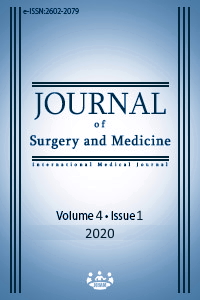Hydatidiform mole in Duhok, Iraq: Frequency, types and histopathological diagnostic features
Keywords:
Hydatidiform mole, Frequency, Types, HistopathologyAbstract
Aim: There is a worldwide variation in the distribution of molar pregnancy with respect to its type. Difficulties in obtaining accurate data about miscarriage make the precise incidence uncertain. The aim of this study was to estimate the frequency of Hydatidiform mole among the miscarriages and deliveries in Duhok province, estimate their main types, partial or complete, and correlate them with histopathological diagnostic features. Methods: This cross-sectional study was conducted between June 1, 2016 and September 1, 2019 and included Hydatidiform mole cases from the main histopathological centers in Duhok and Zakho. All childbirths and miscarriages were evaluated within the same areas and during the same period. Samples were examined histologically and divided into three groups as partial, complete, and indeterminate molar types, after which their correlation with the main histopathological features were examined. Additional efforts were made to identify the indeterminate cases, like the use of P57 marker. Results: The frequency of Hydatidiform mole was less than 1%. Complete type represented 43% of the cases with a relatively high percentage of indeterminate molar pregnancies (26%). The highest percentage of women belonged to the 20-30 years-old group. The most common histological feature was circumferential trophoblastic proliferation. Conclusion: The frequency of Hydatidiform mole in Duhok was within the world range, with a relatively high percentage of indeterminate types. More efforts should be made to establish an accurate diagnosis depending on histopathological features and additional markers like P57 should be used.
Downloads
References
Igwegbe AO, Eleje GU. Hydatidiform mole: a review of management outcomes in a tertiary hospital in south-east Nigeria. Ann Med Health Sci Res. 2013;3(2):210-4.
Seckl MJ, Sebire NJ, Berkowitz RS. Gestational trophoblastic disease. Lancet. 2010;376:717-29.
Boufettal H, Coullin P, Mahdaoui S, Noun M, Hermas S, Samouh N. Complete hydatiforme mole in Morocco: epidemiological and clinical study. J Gynecol Obstet Biol Reprod (Paris). 2011;40:419-29.
Steigrad SJ. Epidemiology of gestational trophoblastic diseases. Best Pract Res Clin Obstet Gynaecol. 2003;17:837-47.
Savage P, Lumsden A, Dickson S, Iyer R, Everard J, Coleman R, et al. The relationship of maternal age to molar pregnancy incidence, risks for chemotherapy and subsequent pregnancy outcome. J Obstet Gynaecol. 2013;33:406-11.
Hui P, Buza N, Murphy K, Ronnett B. Hydatidiform Moles: Genetic Basis and Precision Diagnosis. Annu Rev Pathol. 2017;12:449-85.
Kani K, Lee J, Dighe M, Moshiri M, Kolokythas O, Dubinsky T. Gestatational trophoblastic disease: multimodality imaging assessment with special emphasis on spectrum of abnormalities and value of imaging in staging and management of disease. Curr Probl Diagn Radiol. 2012;41:1-10.
Deng L, Yan X, Zhang J, Wu T. Combination chemotherapy for high-risk gestational trophoblastic tumour. Cochrane Database Syst Rev. 2009;2:51-96.
Joneborg U, Folkvaljon Y, Papadogiannakis N, Lambe M, Marions L. Temporal trends in incidence and outcome of hydatidiform mole: a retrospective cohort study. Acta Oncol. 2018;57(8):1094-9.
Brown J, Naumann R, Seckl M, Schink J. 15 years of progress in gestational trophoblastic disease: scoring, standardization, and salvage. Gynecol Oncol. 2017;144(1):200–7.
Eysbouts Y, Bulten J, Ottevanger P. Trends in incidence for gestacol Oncol. 2016;140(1):70–5.
Matsui H, Kihara M, Yamazawa K, Mitsuhashi A, Seki K, Sekiya S. Recent changes of the incidence of complete and partial mole in Chiba prefecture. Gynecol Obstet Invest. 2007;63(1):7-10.
Altieri A, Franceschi S, Ferlay J, Smith J, Vecchia L. Epidemiology and aetiology of gestational trophoblastic diseases. The Lancet. Oncology. 2003;4(11):670–8.
Soares P, Maestá I, Costa O, Charry R, Dias A, Rudge M. Geographical distribution and demographic characteristics of gestational trophoblastic disease. JRM. 2010;55(7–8):305–10.
Salerno A. The incidence of gestational trophoblastic disease in Italy: a multicenter survey. J Reprod Med. 2012; 57:204–6.
Sebire N, Foskett M, Fisher R, Rees H, Seckl M, Newlands E. Risk of partial and complete hydatidiform molar pregnancy in relation to maternal age. An International Journal of Obstetrics & Gynaecology. 2002;109(1):99-102.
Landolsi H, Missaoui N, Brahem S, Hmissa S, Gribaa M. Pathology research and practice the usefulness of p57 KIP2 immunohistochemical staining and genotyping test in the diagnosis of the hydatidiform mole. Pathol Res Pract. 2011;207:498–504.
Popiolek D, Yee H, Mittal K, Chiriboga L, Prinz M, Caragine T, et al. Multiplex short tandem repeat DNA analysis confirms the accuracy of p57 KIP2 immunostaining in the diagnosis of complete hydatidiform mole. Hum Pathol. 2006;37:1426–34.
Fukunaga M, Katabuchi H, Nagasaka T, Mikami Y, Minamiguchi S, Lage J. Interobserver and intraobserver variability in the diagnosis of hydatidiform mole. Am J Surg Pathol. 2005;29(7):942-47.
Banet N, DeScipio C, Murphy K, Beierl K, Adams E, Vang R, Ronnett B. Characteristics of hydatidiform moles: analysis of a prospective series with p57 immunohistochemistry and molecular genotyping. Mod Pathol. 2014;27(2):238-54.
Downloads
- 794 1430
Published
Issue
Section
How to Cite
License
Copyright (c) 2020 Rana Mumtaz Matlob, Mayada Ilias Yalda, Zihel Hassan Hussein, Tamara Qais Faraj
This work is licensed under a Creative Commons Attribution-NonCommercial-NoDerivatives 4.0 International License.
















